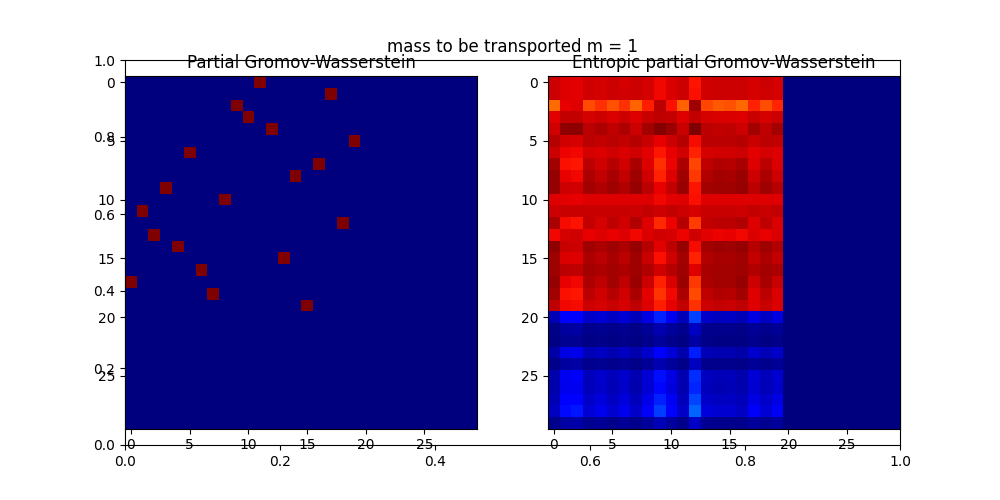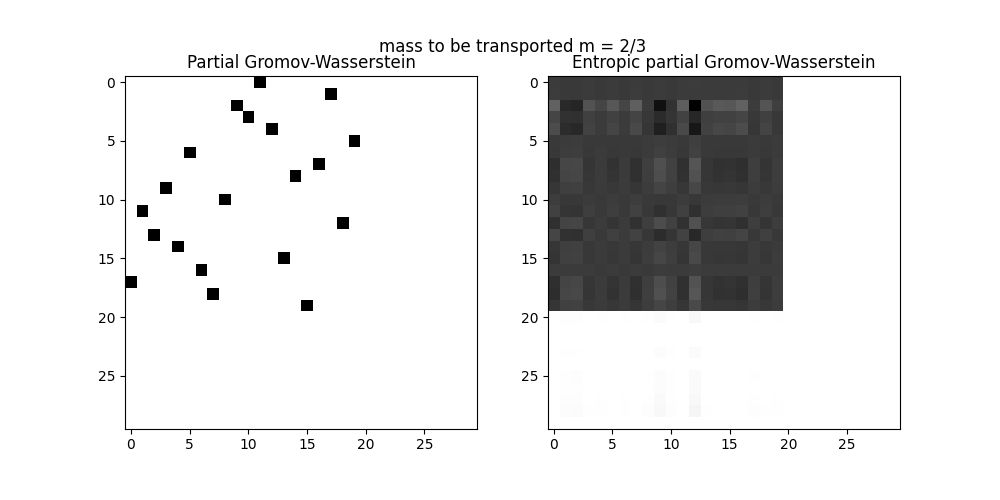Note
Go to the end to download the full example code.
Partial Wasserstein and Gromov-Wasserstein example
Note
Example added in release: 0.7.0.
This example is designed to show how to use the Partial (Gromov-)Wasserstein distance computation in POT [29].
[29] Chapel, L., Alaya, M., Gasso, G. (2020). “Partial Optimal Transport with Applications on Positive-Unlabeled Learning”. NeurIPS.
# Author: Laetitia Chapel <laetitia.chapel@irisa.fr>
# License: MIT License
# sphinx_gallery_thumbnail_number = 2
# necessary for 3d plot even if not used
from mpl_toolkits.mplot3d import Axes3D # noqa
import scipy as sp
import numpy as np
import matplotlib.pylab as pl
import ot
Sample two 2D Gaussian distributions and plot them
For demonstration purpose, we sample two Gaussian distributions in 2-d spaces and add some random noise.
n_samples = 20 # nb samples (gaussian)
n_noise = 20 # nb of samples (noise)
mu = np.array([0, 0])
cov = np.array([[1, 0], [0, 2]])
xs = ot.datasets.make_2D_samples_gauss(n_samples, mu, cov)
xs = np.append(xs, (np.random.rand(n_noise, 2) + 1) * 4).reshape((-1, 2))
xt = ot.datasets.make_2D_samples_gauss(n_samples, mu, cov)
xt = np.append(xt, (np.random.rand(n_noise, 2) + 1) * -3).reshape((-1, 2))
M = sp.spatial.distance.cdist(xs, xt)
fig = pl.figure()
ax1 = fig.add_subplot(131)
ax1.plot(xs[:, 0], xs[:, 1], "+b", label="Source samples")
ax2 = fig.add_subplot(132)
ax2.scatter(xt[:, 0], xt[:, 1], color="r")
ax3 = fig.add_subplot(133)
ax3.imshow(M)
pl.show()
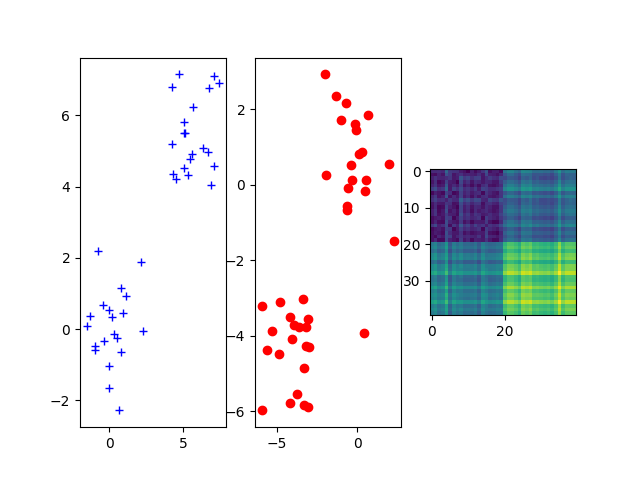
Compute partial Wasserstein plans and distance
p = ot.unif(n_samples + n_noise)
q = ot.unif(n_samples + n_noise)
w0, log0 = ot.partial.partial_wasserstein(p, q, M, m=0.5, log=True)
w, log = ot.partial.entropic_partial_wasserstein(p, q, M, reg=0.1, m=0.5, log=True)
print("Partial Wasserstein distance (m = 0.5): " + str(log0["partial_w_dist"]))
print("Entropic partial Wasserstein distance (m = 0.5): " + str(log["partial_w_dist"]))
pl.figure(1, (10, 5))
pl.subplot(1, 2, 1)
pl.imshow(w0, cmap="gray_r")
pl.title("Partial Wasserstein")
pl.subplot(1, 2, 2)
pl.imshow(w, cmap="gray_r")
pl.title("Entropic partial Wasserstein")
pl.show()
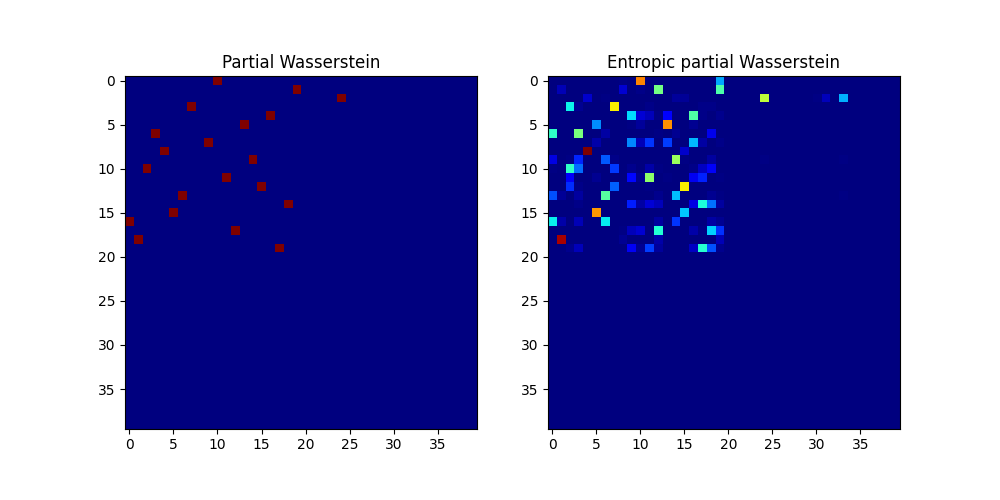
Partial Wasserstein distance (m = 0.5): 0.47910182636916243
Entropic partial Wasserstein distance (m = 0.5): 0.5034205945081645
Sample one 2D and 3D Gaussian distributions and plot them
The Gromov-Wasserstein distance allows to compute distances with samples that do not belong to the same metric space. For demonstration purpose, we sample two Gaussian distributions in 2- and 3-dimensional spaces.
n_samples = 20 # nb samples
n_noise = 10 # nb of samples (noise)
p = ot.unif(n_samples + n_noise)
q = ot.unif(n_samples + n_noise)
mu_s = np.array([0, 0])
cov_s = np.array([[1, 0], [0, 1]])
mu_t = np.array([0, 0, 0])
cov_t = np.array([[1, 0, 0], [0, 1, 0], [0, 0, 1]])
xs = ot.datasets.make_2D_samples_gauss(n_samples, mu_s, cov_s)
xs = np.concatenate((xs, ((np.random.rand(n_noise, 2) + 1) * 4)), axis=0)
P = sp.linalg.sqrtm(cov_t)
xt = np.random.randn(n_samples, 3).dot(P) + mu_t
xt = np.concatenate((xt, ((np.random.rand(n_noise, 3) + 1) * 10)), axis=0)
fig = pl.figure()
ax1 = fig.add_subplot(121)
ax1.plot(xs[:, 0], xs[:, 1], "+b", label="Source samples")
ax2 = fig.add_subplot(122, projection="3d")
ax2.scatter(xt[:, 0], xt[:, 1], xt[:, 2], color="r")
pl.show()
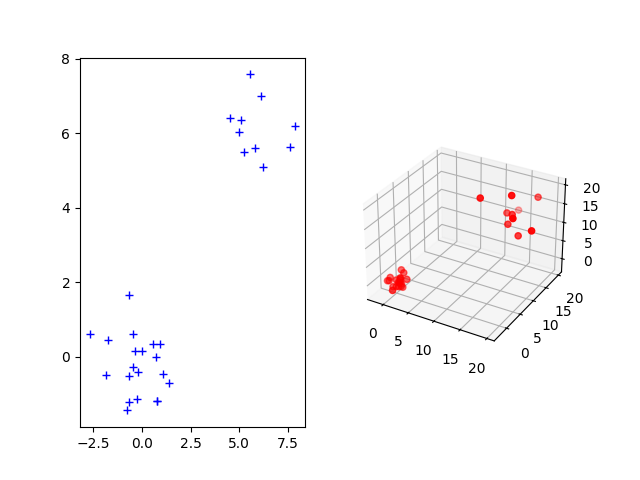
Compute partial Gromov-Wasserstein plans and distance
C1 = sp.spatial.distance.cdist(xs, xs)
C2 = sp.spatial.distance.cdist(xt, xt)
# transport 100% of the mass
print("------m = 1")
m = 1
res0, log0 = ot.gromov.partial_gromov_wasserstein(C1, C2, p, q, m=m, log=True)
res, log = ot.gromov.entropic_partial_gromov_wasserstein(
C1, C2, p, q, 10, m=m, log=True, verbose=True
)
print("Wasserstein distance (m = 1): " + str(log0["partial_gw_dist"]))
print("Entropic Wasserstein distance (m = 1): " + str(log["partial_gw_dist"]))
pl.figure(1, (10, 5))
pl.title("mass to be transported m = 1")
pl.axis("off")
pl.subplot(1, 2, 1)
pl.imshow(res0, cmap="gray_r")
pl.title("Gromov-Wasserstein")
pl.subplot(1, 2, 2)
pl.imshow(res, cmap="gray_r")
pl.title("Entropic Gromov-Wasserstein")
pl.show()
# transport 2/3 of the mass
print("------m = 2/3")
m = 2 / 3
res0, log0 = ot.gromov.partial_gromov_wasserstein(
C1, C2, p, q, m=m, log=True, verbose=True
)
res, log = ot.gromov.entropic_partial_gromov_wasserstein(
C1, C2, p, q, 10, m=m, log=True, verbose=True
)
print("Partial Wasserstein distance (m = 2/3): " + str(log0["partial_gw_dist"]))
print("Entropic partial Wasserstein distance (m = 2/3): " + str(log["partial_gw_dist"]))
pl.figure(2, (10, 5))
pl.title("mass to be transported m = 2/3")
pl.axis("off")
pl.subplot(1, 2, 1)
pl.imshow(res0, cmap="gray_r")
pl.title("Partial Gromov-Wasserstein")
pl.subplot(1, 2, 2)
pl.imshow(res, cmap="gray_r")
pl.title("Entropic partial Gromov-Wasserstein")
pl.show()
------m = 1
It. |Err |Loss
-------------------------------
0|3.301122e-02|1.461179e+02
10|2.713289e-12|1.324561e+02
Wasserstein distance (m = 1): 130.7614207044578
Entropic Wasserstein distance (m = 1): 132.4560947951444
------m = 2/3
It. |Err |Loss
-------------------------------
0|2.040627e-02|1.273358e+01
10|2.715953e-11|8.828492e-01
Partial Wasserstein distance (m = 2/3): 0.2348794356788732
Entropic partial Wasserstein distance (m = 2/3): 0.8828491877294617
Total running time of the script: (0 minutes 2.104 seconds)
